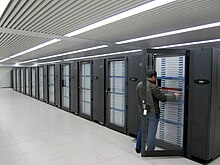
Back تيانهي-1 Arabic Tianhe-I Catalan Tchien-che 1 Czech Tianhe-I Danish Tianhe-1A German Tianhe-I Spanish تیانهه-۱ Persian Tianhe-I French טיאנחה-1 HE तिआन्हे १ Hindi
 | |
| Active | Tianhe-1 Operational 29 October 2009, Tianhe-1A Operational 28 October 2010 |
|---|---|
| Sponsors | National University of Defense Technology |
| Operators | National Supercomputing Center |
| Location | National Supercomputing Center, Tianjin, People's Republic of China |
| Operating system | Linux[1] |
| Memory | 96 TB (98304 GB) for Tianhe-1, 262 TB for Tianhe-1A |
| Speed | Tianhe-1: 563 teraFLOPS (Rmax) 1,206.2 teraFLOPS (Rpeak), Tianhe-1A: 2,566.0 teraFLOPS (Rmax) 4,701.0 teraFLOPS (Rpeak) |
| Ranking | TOP500: 2nd, June 2011 (Tianhe-1A) |
| Purpose | Petroleum exploration, aircraft simulation |
| Sources | top500.org |
| Tianhe-1 | |||||||
|---|---|---|---|---|---|---|---|
| Simplified Chinese | 天河一号 | ||||||
| Traditional Chinese | 天河一號 | ||||||
| Literal meaning | "Milky Way No.1" | ||||||
| |||||||
Tianhe-I, Tianhe-1, or TH-1 (Chinese: 天河一号, [tʰjɛ́nxɤ̌ íxâʊ]; Sky River Number One)[2] is a supercomputer capable of an Rmax (maximum range) of 2.5 peta FLOPS. Located at the National Supercomputing Center of Tianjin, China, it was the fastest computer in the world from October 2010 to June 2011 and was one of the few petascale supercomputers in the world.[3][4]
In October 2010, an upgraded version of the machine (Tianhe-1A) overtook ORNL's Jaguar to become the world's fastest supercomputer, with a peak computing rate of 2.57 petaFLOPS.[5][6] In June 2011 the Tianhe-1A was overtaken by the K computer as the world's fastest supercomputer, which was also subsequently superseded.[7]
Both the original Tianhe-1 and Tianhe-1A use a Linux-based operating system.[8][9]
On 12 August 2015, Tianhe-1 felt the impact of the powerful Tianjin explosions and went offline for some time. Xinhua reports that "the office building of Chinese supercomputer Tianhe-1, one of the world's fastest supercomputers, suffered damage". Sources at Tianhe-1 told Xinhua that the computer was not damaged, but that they had shut down some of its operations as a precaution.[10] Operation resumed on 17 August 2015.[11]
- ^ "Tianhe-1 - NUDT TH-1 Cluster, Xeon E5540/E5450, ATI Radeon HD 4870 2, Infiniband | TOP500".
- ^ "China takes HPC heavyweight title". 28 October 2010.
- ^ China's Defense University builds World Third fastest supercomputer, china-defense-mashup.com, 29 October 2009, retrieved 29 October 2009
- ^ "我国首台千万亿次超级计算机研制成功 (China builds its first petaFLOP level supercomputer)" (in Chinese). SINA.com News and XinhuaNet.com News. 29 October 2009. Retrieved 29 October 2009.
- ^ "China claims supercomputer crown". BBC. 29 October 2010. Retrieved 29 October 2010.
- ^ Richard Stone and Hao Xin (5 November 2010). "Supercomputer Leaves Competition - And Users - in the Dust". Science. 330 (6005): 746–747. Bibcode:2010Sci...330..746S. doi:10.1126/science.330.6005.746-a. PMID 21051607.
- ^ Chivers, Tom (20 June 2011). "Japanese supercomputer 'K' is world's fastest". The Telegraph. London. Retrieved 20 June 2011.
- ^ CBC News (October 2010). "China's supercomputer called world's fastest - Tianhe-1 can make 2,57 trillion calculations per second". Canadian Broadcasting Corporation. Retrieved 28 October 2010.
- ^ srlinuxx (May 2010). "Nearly every supercomputer runs Linux". Tux Machines. Retrieved 28 October 2010.
- ^ Xinhua News (August 2015). "At least 17 killed, 400 injured in massive Tianjin blasts". Archived from the original on 14 August 2015. Retrieved 13 August 2015.
- ^ "China's super computer Tianhe-1 re-started after Tianjin blasts". Economic Times World News. 17 August 2015. Retrieved 17 August 2015.
© MMXXIII Rich X Search. We shall prevail. All rights reserved. Rich X Search